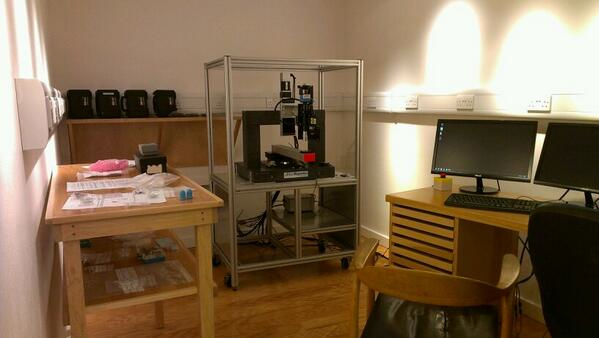One year in: the story so far…
The NanoPaleoMag project will be one year old tomorrow. On the eve of our first birthday, I thought this would be a good time to look back over all that has happened during the past year, and look forward to what is to come next…
The major milestone defined for the first year was the preparation and installation of key laboratory equipment. This task began in earnest last summer with the arrival of Gary Scott, Bruce, Bruce, Bruce and Bruce and the installation of our magnetically shielded room. Later in the year saw the arrival of our Lakeshore PMC vibrating sample magnetometer/alternating gradient magnetometer. Just a few weeks ago we installed our custom built Micro Magnetics MTJ scanning microscope into the shielded room. Finally (although it is still in its box) we saw the arrival of our last major piece of lab infrastructure: an ASC scientific AF demagnetiser/ARM magnetiser. A big thanks to all the technical staff for helping to get things set up smoothly, and to Julie in the office for handling all the invoices!
Another major task was to find people to make use of all the shiny new kit. First to arrive was post doc Nono Lascu, who brought a wealth of experience in rock and environmental magnetism with him from his time at the Institute for Rock Magnetism. Nono’s main task from now on will be to explore the new opportunities for highly targeted paleomagnetic measurements using the MTJ microscope. June will see the arrival of our second post doc Josh Einsle. Josh is a dual beam FIB applications specialist with many years experience working on both sides of the microscopy fence (both as a researcher and as an employee of FEI). Josh’s main task will be to apply advanced electron microscopy techniques, such as slice-and-view tomography, to our natural samples – allowing us to feed the positions, sizes, shapes and orientations of remanence carriers into computer models of how the sample should behave. Next to arrive in October will be our three new PhD students (Claire, Joy and Roberts), who will each be working on complementary aspects of the project.
In addition to all the work preparing the labs, we’ve also had time to fit in some fundamental research, publish several key papers, make many conference contributions, and release a brand new version of FORCinel. The most exciting and significant development has been the success of our first experiments using synchrotron X-rays to image natural remanent magnetisation at the nanoscale in Fe-Ni meteorites. Together with PhD student James Bryson, we have already achieved one of the long-term goals of the project by successfully demonstrating that paleomagnetic information can be extracted from the Fe-Ni meteorites at sub-micron length scales using XPEEM (the very definition of nanopaleomagnetism).
So one year down, four more to go. Exciting times ahead!
Richard Harrison



Leave a Reply